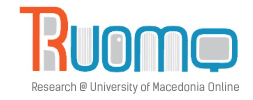Παρακαλώ χρησιμοποιήστε αυτό το αναγνωριστικό για να παραπέμψετε ή να δημιουργήσετε σύνδεσμο προς αυτό το τεκμήριο:
https://ruomo.lib.uom.gr/handle/7000/1284Πλήρης εγγραφή μεταδεδομένων
| Πεδίο DC | Τιμή | Γλώσσα |
|---|---|---|
| dc.contributor.author | Laios, Alexandros | - |
| dc.contributor.author | Kalampokis, Evangelos | - |
| dc.contributor.author | Johnson, Racheal | - |
| dc.contributor.author | Thangavelu, Amudha | - |
| dc.contributor.author | Tarabanis, Constantine | - |
| dc.contributor.author | Nugent, David | - |
| dc.contributor.author | De Jong, Diederick | - |
| dc.date.accessioned | 2022-09-21T10:43:23Z | - |
| dc.date.available | 2022-09-21T10:43:23Z | - |
| dc.date.issued | 2022-04-10 | - |
| dc.identifier | 10.3390/jpm12040607 | en_US |
| dc.identifier.issn | 2075-4426 | en_US |
| dc.identifier.uri | https://doi.org/10.3390/jpm12040607 | en_US |
| dc.identifier.uri | https://ruomo.lib.uom.gr/handle/7000/1284 | - |
| dc.description.abstract | Complete surgical cytoreduction (R0 resection) is the single most important prognosticator in epithelial ovarian cancer (EOC). Explainable Artificial Intelligence (XAI) could clarify the influence of static and real-time features in the R0 resection prediction. We aimed to develop an AI-based predictive model for the R0 resection outcome, apply a methodology to explain the prediction, and evaluate the interpretability by analysing feature interactions. The retrospective cohort finally assessed 571 consecutive advanced-stage EOC patients who underwent cytoreductive surgery. An eXtreme Gradient Boosting (XGBoost) algorithm was employed to develop the predictive model including mostly patient- and surgery-specific variables. The Shapley Additive explanations (SHAP) framework was used to provide global and local explainability for the predictive model. The XGBoost accurately predicted R0 resection (area under curve [AUC] = 0.866; 95% confidence interval [CI] = 0.8-0.93). We identified "turning points" that increased the probability of complete cytoreduction including Intraoperative Mapping of Ovarian Cancer Score and Peritoneal Carcinomatosis Index < 4 and <5, respectively, followed by Surgical Complexity Score > 4, patient's age < 60 years, and largest tumour bulk < 5 cm in a surgical environment of optimized infrastructural support. We demonstrated high model accuracy for the R0 resection prediction in EOC patients and provided novel global and local feature explainability that can be used for quality control and internal audit. | en_US |
| dc.language.iso | en | en_US |
| dc.rights | Attribution-NonCommercial-ShareAlike 4.0 International | * |
| dc.rights.uri | http://creativecommons.org/licenses/by-nc-sa/4.0/ | * |
| dc.source | Journal of personalized medicine | en_US |
| dc.subject | FRASCATI::Medical and Health sciences::Clinical medicine | en_US |
| dc.subject | FRASCATI::Engineering and technology::Electrical engineering, Electronic engineering, Information engineering | en_US |
| dc.subject.other | Explainable Artificial Intelligence | en_US |
| dc.subject.other | complete cytoreduction | en_US |
| dc.subject.other | epithelial ovarian cancer | en_US |
| dc.title | Explainable Artificial Intelligence for Prediction of Complete Surgical Cytoreduction in Advanced-Stage Epithelial Ovarian Cancer | en_US |
| dc.type | Article | en_US |
| dc.contributor.department | Τμήμα Οργάνωσης & Διοίκησης Επιχειρήσεων | en_US |
| local.identifier.volume | 12 | en_US |
| local.identifier.issue | 4 | en_US |
| local.identifier.firstpage | 607 | en_US |
| Εμφανίζεται στις Συλλογές: | Τμήμα Οργάνωσης & Διοίκησης Επιχειρήσεων | |
Αρχεία σε αυτό το Τεκμήριο:
| Αρχείο | Περιγραφή | Μέγεθος | Μορφότυπος | |
|---|---|---|---|---|
| jpm-12-00607-v2.pdf | 2,24 MB | Adobe PDF |  Προβολή/Ανοιγμα |
Αυτό το τεκμήριο προστατεύεται από Αδεια Creative Commons

